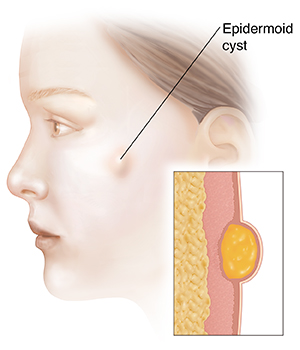Understanding Epidermoid Cyst
Understanding Epidermoid Cyst
An epidermoid cyst is a small abnormal growth in the top layers of the skin. It is filled with keratin, the same proteins that make up your hair and nails. These cysts grow slowly. They can grow anywhere on the body. But they are most often found on the face, behind the ears, and on the chest or upper back.
How to say it
ep-ih-DUHR-moid sist
What causes an epidermoid cyst?
An epidermoid cyst may occur because of an injury to the skin or from acne.
Symptoms of an epidermoid cyst
An epidermoid cyst is a subcutaneous bump. This means it is just below the skin. It may be yellow or skin-colored. It often has a small black mark in the middle of it, like a blackhead.
An epidermoid cyst rarely causes pain, unless it ruptures or becomes infected. It may ooze keratin, a white, cheesy, smelly material. If the cyst becomes inflamed or infected, it may be:
Bad smelling
Red
Swollen
Tender
Treatment for an epidermoid cyst
Many epidermoid cysts don’t cause any problems. They don’t necessarily need to be treated. They may go away on their own. But you may want to treat it if you don’t like how it looks or it becomes inflamed. Treatment options include:
Steroid injection. A steroid may be injected into the cyst. This may help ease inflammation. It may also prevent infection.
Surgical removal. The cyst can be cut out. It may also need to be drained first. There is a slight chance the cyst may come back.
Antibiotics. In some cases, you may need to take an oral antibiotic to prevent infection and regrowth.
When to call your healthcare provider
Call your healthcare provider right away if you have any of these:
Fever of 100.4°F (38°C) or higher, or as directed
Redness, swelling, or fluid leaking from your incision that gets worse
Pain that gets worse
Symptoms that don’t get better, or get worse
New symptoms
Updated:
March 21, 2017
Sources:
Goldstein BG, et al. Overview of benign lesions of the skin. Up To Date. November 11 ed: Up To Date; 2015. p. 105., Habif TP, et al. Benign skin tumors. In: Habib TP, editor. Clinical Dermatology. 6 ed. Philadelphia: Elsevier; 2016. p. 784-808., Leung AKC, et al. Epidermoid Cyst. International Journal of Clinical & Medical Imaging. 2014 November 1;1(11)., Marghoob AA, et al. Dermoscopic evaluation of skin lesions. Up To Date. August 5 ed: Up To Date; 2015. p. 73., Stone MS, et al. Cysts. In: Bolognia JL, et al, editors. Dermatology. 3 ed. Philadelphia: Elsevier; 2012. p. 1817-28.
Reviewed By:
Berman, Kevin, MD,Image reviewed by StayWell medical illustration team.,Ziegler, Olivia, MS, PA
